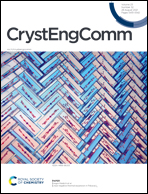Synthesis and characterization of new coordination compounds by the use of 2-pyridinemethanol and di- or tricarboxylic acids†
Abstract
The development of synthetic approaches towards new coordination polymers has attracted significant interest due to their fascinating physical properties, as well as their use in a wide range of technological, environmental and biomedical applications. Herein, the initial combination of 2-pyridinemethanol (Hhmp) with 1,4-benzenedicarboxylic acid (H2bdc) or 1,3,5-benzenetricarboxylic acid (H3btc) has been proven a fruitful source of such new species providing access to five new coordination compounds, namely [M2(Hbtc)2(Hhmp)4]·DMF (M = CoII, 1·DMF;NiII, 2·DMF), [Ni(bdc)(Hhmp)2]n·4H2O (3·4H2O), [Zn2(bdc)(hmp)2]n·DMF (4·DMF) and [Fe3(bdc)3(Hhmp)2]n (5). 4·DMF and 5 are the first metal–organic frameworks (MOFs) based on Hhmp with 4 exhibiting an unprecedented 4,4,4-c net with the point symbol {32·103·11}{32·104}2. The framework of 5 is based on a linear FeII3 SBU and possesses a 3,4,6T2 topology with the point symbol {42·83·10}3{43}2{46·86·103}. DC magnetic susceptibility measurements were carried out in 5 and revealed the existence of antiferromagnetic coupling between the FeII cations with a superexchange value of J = −8.46 cm−1.

- This article is part of the themed collection: Coordination Networks


 Please wait while we load your content...
Please wait while we load your content...